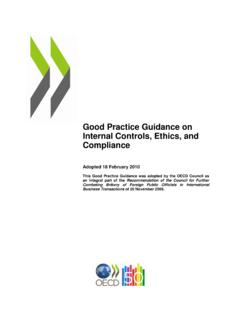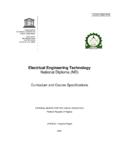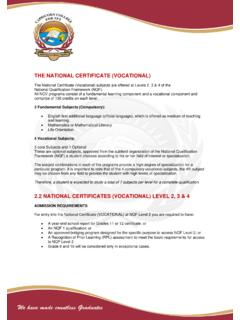Transcription of MEASURING SCIENCE, TECHNOLOGY AND …
1 MEASURING . SCIENCE, TECHNOLOGY . AND innovation . MEASURING . Science, TECHNOLOGY and innovation Sound measurement is crucial for better policies in science, TECHNOLOGY and innovation . Experimentation with metrics based on new tools and data, or new ways of using existing data, are needed to provide insights into emerging areas of policy interest, provoke debate and move the measurement agenda forward.. Andrew Wyckoff Science, TECHNOLOGY and innovation Director, OECD. 2016. Contents MEASURING R&D 2. Digital readiness 4. ICT usage 6. Emerging and converging technologies 8. Human resources in S&T 10. innovation 11. Knowledge-based capital 12. Global interdependencies 14. The Micro-data Lab 18. Distributed micro-data analysis 24. Public support to innovation 26. Platforms, databases and publications 30. MEASURING R&D Among the G20, Korea has the highest ratio of R&D expenditure to GDP at RESEARCH & DEVELOPMENT (R&D) government budgets for R&D; and historical OECD R&D data (1962-80).
2 MEASURING R&D in a way that makes the data internationally comparable is The OECD Analytical Business Enterprise not an easy task; that's why the OECD Research & Development (ANBERD). Frascati Manual was first developed in 1963. database builds upon RDS to give Nowadays, this international standard is the industry-level insights on R&D through basis of R&D statistics in OECD countries detailed breakdowns covering both and beyond. It also underpins the definition services and manufacturing. of R&D used in accounting standards and in the UN System of National Accounts. The Frascati definition of The biannual OECD Main Science and TECHNOLOGY Indicators (MSTI). R&D is widely used for policy purposes, too. series presents a wide range of timely reference indicators used by policymakers and economic analysts. These cover The OECD National Experts on Science and TECHNOLOGY Indicators the financial and human resources devoted to R&D since (NESTI) recently oversaw the 6th revision of the Frascati Manual 1981 alongside complementary indicators on patents and improving its clarity and enhancing its relevance through greater international aspects of science and TECHNOLOGY .
3 Compatibility with other statistics and new statistical guidance on R&D tax incentives and globalisation. What do we mean by R&D? R&D comprises basic research (aimed at creating The OECD Research & Development Statistics (RDS) database, released new knowledge with no specific application in view), annually in March-April, offers data exploration and extraction applied research (new knowledge towards a specific for analysis covering OECD members and other major economies practical aim) and experimental development (to fulfilling the standards of the OECD Frascati Manual: R&D spending develop new products or processes). and funding; R&D personnel numbers, qualifications, and gender;. 2 . MEASURING SCIENCE, TECHNOLOGY AND innovation . Researchers and R&D spending, 2014. Did you 18. R&D expenditures in 2010 USD. OECD average = constant prices and PPP ISR. According to OECD RDS historical data, in the 16 1 billion 1960s nearly 70% of all business R&D in the FIN.
4 Largest OECD countries was directly funded by 10 billion DNK. government. This figure is now close to 10%. 14. SWE KOR. 100 billion Researchers, per thousand employment 12. ISL. NOR BEL JPN. 10 FRA AUT. USA. GBR SVN. OECD average IRL AUS. CAN. PRT NLD. = 8 DEU. 8. GRC NZL. EST CHE. ESP LUX. SVK CZE. 6 RUS HUN. POL ITA. 4. TUR. OECD R&D experts, Villa Falconieri, Frascati, in the 1960s. BRA. BRICS. 2 CHN North America Find out more: CHL. ZAF European Union Frascati Manual MEX Other OECD members RDS 0 ANBERD Gross domestic expenditures on R&D as a percentage of GDP. MSTI Sources: OECD Main Science and TECHNOLOGY Indicators (MSTI); UNESCO Institute for Statistics, July 2016. MEASURING R&D . 3. Digital readiness 100 million In 2015, there were more than 100 million SIM cards for machine-to-machine communication in the 26 OECD countries for which data is available. ICT INFRASTRUCTURE SIM cards for machine-to-machine (M2M) usage account for a growing segment of mobile data subscriptions.
5 These devices connect The OECD collects information and communication TECHNOLOGY (ICT) millions of sensors, providing ever-greater amounts of big data to infrastructure statistics to analyse the sector's development and to facilitate the monitoring of machines, environments and people's help policy makers in selecting best practices. Most OECD countries health. put national digital strategies high on their agendas in order to M2M mobile cellular subscriptions, June 2015. promote the development of telecommunication infrastructure and services. It is a priority for the OECD to monitor these objectives, M2M cards, per 100 inhabitants (left-hand side) M2M cards, million (right-hand side). which include: increased broadband capacity and speed; increased Million 69. broadband coverage to better connect remote areas; and improved 30 12. resilience of existing broadband infrastructure. USA. 49 million cards Japan million cards 10.
6 Main trends in communication policy and regulation as well as in communication markets, prices, broadband speeds and network 20 8. development analysis are included in the Digital Economy Outlook (DEO). 6. 10 4. 2. 0 0. Find out more: E. L. R. N. A. D. A. K. A. T. L. L. N. N. U. P. R. E. R. T. NZ. BE. IR. SW. CZ. ES. PR. ES. NO. KO. GB. DN. IT. FR. US. DE. FI. JP. CA. NL. DEO 2015 OECD Broadband Portal Source: OECD Broadband Portal, , August 2016. 4 . MEASURING SCIENCE, TECHNOLOGY AND innovation . SKILLS FOR THE DIGITAL ECONOMY. Did you Greater use of digital technologies increases demand for ICT skills. Yet, the proportion of workers using office software (word processors, spreadsheets) daily differs significantly across On average, only a quarter of all workers use countries, ranging from 38% in the Netherlands to 18% in Poland. office software daily. Of these, according to the OECD Survey of Adult Skills (PIAAC), over 40 %.
7 Daily users of office software at work, by ICT skills, 2013. may lack the skills to use these tools effectively. As a percentage of all workers % All users Of which, users with insufficient ICT skills But digital natives are on the rise. On average, 40 15-year-olds in the OECD spend about three hours per day on the Internet on a typical weekday. 30. 20. 10. 0. N. E. E. L. T. N. K. L. Ire gl D. S. N. K. U. R. av A. e T. K). nd d/. IR. PO. SW. CZ. AU. ES. AU. ag NO. SV. DN. US. DE. JP. FI. CA. N. En NL. (U. la an Find out more: er try OECD (2016), Skills for a Digital World , OECD. un Co Digital Economy Papers, No. 250, OECD Publishing, Source: OECD elaborations based on the PIAAC database, January 2016. Paris, Data on the frequency of ICT use at work permit the measurement of ICT intensity OECD (2016), New Skills for the Digital Economy , in different occupations. Women typically use the Internet less than men and their OECD Digital Economy Papers, No.
8 258, OECD. participation in ICT occupations remains low as well (women account for 18% of ICT Publishing, Paris, specialists in OECD countries). DIGITAL READINESS . 5. ICT usage 80%. Over 80% of adults and 96% of 16-24 year-olds in the OECD use the Internet, most of them on a daily basis. ICT USE IN BUSINESSES AND HOUSEHOLDS The OECD has been setting statistical standards in this area since 2008, encompassing definitions (electronic commerce transactions, Almost no business today is run without the help of information and content and media sector), classifications (ICT goods and services). communication technologies (ICTs). However, while almost every and model surveys (ICT usage by households, individuals and enterprise has a broadband connection and near eight out of ten businesses). a web site, only four out of ten are purchasing online or use social media. Find out more: MEASURING the Information Economy ICTs are now widely diffused also among households and individuals.
9 Uptake of ICTs and business processes, 2015. Still, usage rates and online activities significantly vary across OECD. As a percentage of enterprises with ten or more persons employed countries and among social groups. Gap 1st and 3rd quartiles Average Lowest Highest %. Data availability for specific indicators depends on surveys 100. undertaken on a multi-year or occasional basis in some countries, 80. and annually in others (EU28). Data collection practices also differ: 60. ICT usage is not always monitored by means of a dedicated survey. 40. The OECD is actively engaged in work to facilitate the collection of 20. comparable information in this field through its Model Survey on ICT 0. Access and Usage by Households and Individuals and by Businesses. s es ia of rce e g s ). ID. nd DE. e le ar tin ed sit as RF. sa )s u tw ba (A. pu h lm RP so E- eb rc ad t. (E Re m cia ng pu W. It also encourages the co-ordinated collection of statistics on usage.
10 O co Br ng ise m E- So d ni pr in ou ha an er Cl in particular on emerging topics, such as privacy, security, children Pl Ent c ly pp Su online, cloud computing or the sharing economy. Sources: OECD, ICT Database; Eurostat, Information Society Statistics database, April 2016. 6 . MEASURING SCIENCE, TECHNOLOGY AND innovation . Internet users by age, 16-24 and 65-74 year-olds, 2014, G20 economies Did you As a percentage of population in each age group %. Total users 16-24 year-olds 65-74-year-olds Whose YouTube content are they watching? 100. YouTube data can be used to show how much content is viewed outside the country in which it was uploaded. In 2014, 85% of the hours watched for videos uploaded by 80. users in Japan were from users located in Japan, while in Australia and Canada only 8% of watched YouTube content was locally 60. uploaded. On average people watch a little bit of lots of things . But all watching countries in 2014 spent 10% or more of their watch hours on US-uploaded content.












